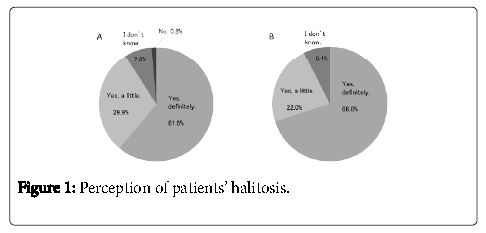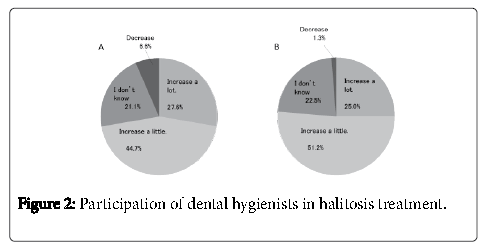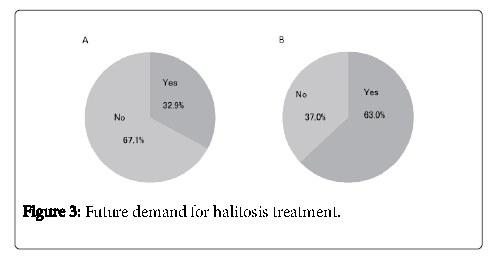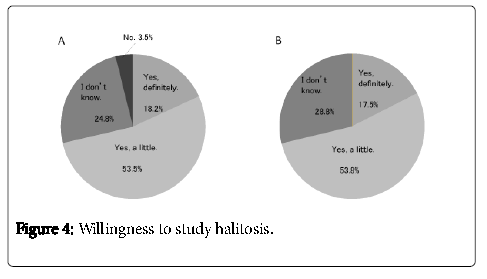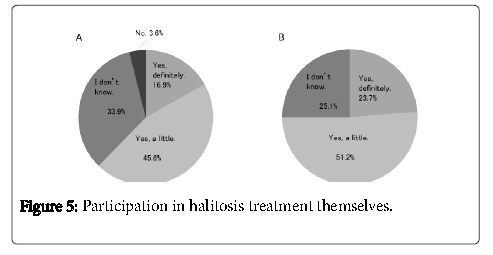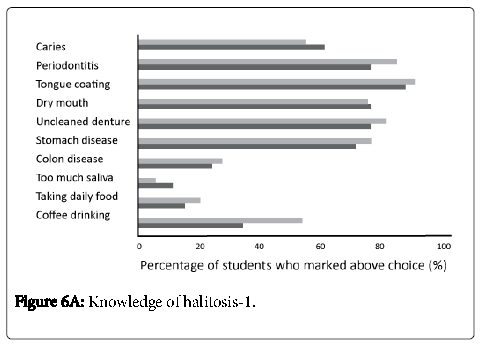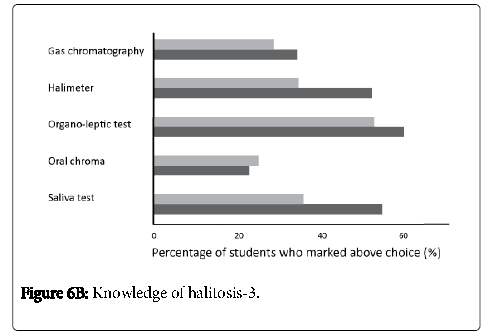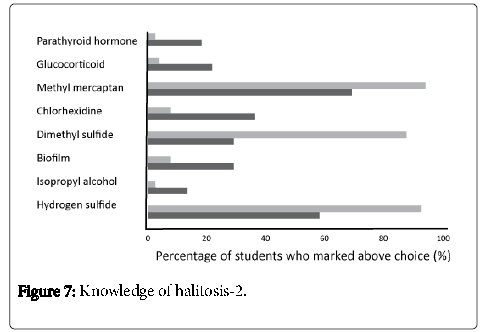Research Article Open Access
Awareness and Knowledge of Halitosis: Comparison of Two Grades of Dental Hygienist Students
Inoue E1, Yoneda M2*, Suzuki N3, Matsuo T4, Ishii A4, Haraga M5, Hirahashi K5, Morita H2, Koga C5, Inoue Y4, Yasukouchi H1 and Hirofuji T2
1Dental Hygienist Division, Fukuoka Dental College Medical and Dental Hospital, Japan
2Section of General Dentistry, Department of General Dentistry, Fukuoka Dental College, Japan
3Section of Oral Public Health, Department of Preventive and Public Health, Fukuoka Dental College, Japan
4Department of Dental Hygiene, Fukuoka College of Health Science, Japan
4Center for Oral Diseases, Fukuoka Dental College, Japan
- *Corresponding Author:
- Masahiro Yoneda
Department of General Dentistry
Fukuoka Dental College, Japan
Tel: +81-92-801-0411
E-mail: yoneda@college.fdcnet.ac.jp
Received Date: October 26, 2016; Accepted Date: November 22, 2016; Published Date: November 28, 2016
Citation: Inoue E, Yoneda M, Suzuki N, Matsuo T, Ishii A, et al. (2016) Awareness and Knowledge of Halitosis: Comparison of Two Grades of Dental Hygienist Students. J Oral Hyg Health 4: 211. doi:10.4172/2332-0702.1000211
Copyright: © 2016 Inoue E, et al. This is an open-access article distributed under the terms of the Creative Commons Attribution License, which permits unrestricted use, distribution and reproduction in any medium, provided the original author and source are credited.
Visit for more related articles at Journal of Oral Hygiene & Health
Abstract
Many people worry about their breath odor, and the importance of halitosis treatment is increasing. Consequently, it is necessary for dental hygienists to obtain a basic knowledge of halitosis. To achieve this, we must improve the motivation of dental hygienist students to acquire such knowledge. To this end, we conducted a questionnaire survey to assess the awareness and knowledge of the problem among dental hygienist students and compared the results of the survey for students in the first and third grades.
The percentage of students who perceived the oral malodor of patients was higher in the third grade group. The third graders also placed a greater importance on the participation of dental hygienists in halitosis treatment. Most students in both grades believed that demand for halitosis treatment would increase, although there were students in the first grade that did not hold this view. A similar percentage of students in the two grades were willing to study halitosis, although some first grade students were not at all interested. Many more students in the third grade wanted to take part in halitosis treatment. Student knowledge of halitosis was approximately the same in both grades, but, surprisingly, the third graders gave some incorrect answers in this area.
From the results of this study, the third grade students appeared to have higher motivation to study halitosis treatment than the first graders. However, the upper grade students seemed to lack some knowledge, which may be due to the extended time since they had studied the topic at school. It is necessary for us to improve student motivation for studying halitosis and for maintaining their knowledge in order to better perform the treatment of halitosis after the students become dental hygienists.
Keywords
Oral malodor; Halitosis; Education; Dental hygienists; Questionnaire survey
Introduction
Oral malodor is a common complaint among the general population and is primarily associated with conditions in the oral cavity, including oral hygiene status and periodontal condition [1,2]. Oral malodor mainly results from microbial metabolism of amino acids in local debris [3,4]. Some cases of halitosis result from systemic disorders [5], and dentists must perform careful examination to arrive at the proper diagnosis. Moreover, halitosis can play a role in social anxiety disorders [6], and dental professionals need to support patients by understanding their mental health conditions.
Dental hygienists are often the first to encounter halitosis patients at dental clinics, and they may spend more time with patients than do dentists. Therefore, dental hygienists play an important role in halitosis treatment. However, our recent study revealed that dental hygienists did not necessarily have sufficient knowledge of halitosis [7].
We believe that dental hygienists need a greater knowledge of halitosis. To achieve this, it is important to evaluate the motivation and knowledge of dental hygienist students regarding halitosis. In this study, we conducted a questionnaire survey of dental hygienist students and compared results for two student grades.
Materials and Methods
Students
The dental hygienist students of the Fukuoka College of Health Science go to school for total of three years. In the first year, they receive lectures on halitosis. In the third grade, they attend an on-thejob training at the main hospital (Fukuoka Dental College Medical and Dental Hospital) and also at a satellite clinic (Fukuoka Dental College Center for Oral Diseases). Anonymous questionnaires were prepared and administered to first grade (after lectures of halitosis were all over) and to third grade students (in the middle of on-the-job training) of the college. Written informed-consent forms were received from all the students. All agreed that their responses could be used for this research.
Results
Valid response rate
From a total of 79 first grade students, 75 returned completed answer sheets (valid response rate: 94.9%). From a total of 84 third grade students, 81 returned completed answer sheets (valid response rate: 96.4%).
Perception of patients’ oral malodor
We first asked students if they had ever perceived a patient’s oral malodor (Figure 1). Among the first grade respondents, 32.9% answered that they had. On the other hand, 60.7% of the third grade students reported experiencing a patient’s oral malodor.
Awareness of participation of dental hygienists in halitosis treatment
We then asked the students if they believed that dental hygienists should participate in halitosis treatment (Figure 2). Students in both grades responded that they should. However, the third grade students felt more strongly about such participation.
Students’ thinking on future demand of halitosis treatment
Students were asked about their expectation of future demand for halitosis treatment (Figure 3). Many students from both grades expected that the demand for halitosis treatment would increase. However, a few more students from the first grade thought that the demand might decrease.
Willingness to study halitosis
We asked the students if they wished to study halitosis (Figure 4). The percentage of students who expressed a willingness to study the problem was almost the same in both classes. However, some first grade students indicated that they did not want to engage in such study.
Participation in halitosis treatment by the students themselves
We asked the students if they wanted to participate in halitosis treatment themselves (Figure 5). Approximately 61% of the first grade students indicated that they would want to take part. On the other hand, more than 71% of the third grade students wanted to participate. Approximately 4% of the first grade students did not want to take part in halitosis treatment.
Knowledge of halitosis
Lastly, we compared the third grade students’ knowledge of halitosis to that of the first grade students. Knowledge of the causes of oral malodor and the apparatus used to measure it was nearly the same between two groups (Figures 5, 6A and 6B). However, more students in the third grade answered incorrectly a question about oral malodorassociated gasses (Figure 7). They chose some correct answers, but they also marked wrong choice such as parathyroid hormone.
Discussion
An increasing number of patients are visiting halitosis clinics. Our college has two halitosis clinics, one in the main hospital and one in a satellite clinic. More than 500 patients have come to the two clinics a year. According to our data, more than 60% of the halitosis patients were female, some of whom had severe anxiety [8]. Dental hygienists usually talk with these patients before treatment by a dentist, and they can sometimes relieve the patient’s anxiety. Dental hygienists also play an important role in periodontal treatment and oral hygiene instruction [9]. Given these facts, dental hygienists need to have sufficient knowledge of halitosis. However, our recent survey revealed that dental hygienists do not necessarily have the knowledge that is required [7]. To improve the dental hygienist’s knowledge of halitosis, it is important to improve motivation and knowledge of halitosis treatment beginning in the dental hygienist’s student days. To evaluate student awareness and knowledge of halitosis, we conducted a questionnaire survey of first and third grade students.
It is reasonable to expect that more students in the third grade have experienced oral malodor from at least some of their patients, since they have more opportunities to see patients at the hospitals. The third grade students were more likely to recognize the importance of dental hygienists in halitosis treatment, and they generally believe that the need for halitosis treatment will increase. The first grade students are less interested in studying halitosis and taking part in halitosis treatment. The experience of third grade students at the hospitals may be associated with the higher motivation of the third grade students with regard to halitosis treatment. Actually dental hygienists in our hospitals are playing an important role [10], and the third grade students may have seen their activity which resulted in higher motivation.
The results related to student knowledge of halitosis were unexpected. The third grade students did not necessarily have more knowledge than the first graders. Moreover, some knowledge that they should have acquired in the first year was apparently forgotten by the upper grade students. Students learn about halitosis in the first year, but they do not study it again until the time of national examination. Their knowledge may disappear during the two intervening years.
To provide better halitosis treatment, teachers need to improve the motivation of dental hygienist students in this area. Teachers also need to give the students sufficient knowledge of halitosis and find ways to ensure that the students retain their basic knowledge.
Conclusion
The percentage of students who experienced oral malodor from their patients was higher among third grade students. The third grade students believed more strongly that dental hygienists should take part in halitosis treatment as compared to the first grade students. More students in the third grade believed that future demand for halitosis treatment would increase as compared to the first grade students. Motivation for studying halitosis was higher among the third grade students. Third grade students seemed to be more positive in contributing to halitosis treatment themselves. Knowledge of the causes of oral malodor and the apparatus used to measure it was not different between the two grades, but knowledge of the oral malodorassociated gasses was lower among the third grade students.
Acknowledgement
This study was in part supported by a Grant-in-Aid for Scientific Research (C) 16K11577 (M.Y.) and Grants-in-Aid for Advanced Science Research (M.Y., T.H.) from the Ministry of Education, Culture, Sports, Science, and Technology, Japan.
References
- Tonzetich J (1977) Production and origin of oral malodor: a review of mechanisms and methods of analysis. J Periodotol 48: 13-20.
- Yaegaki K, Coil JM (2000) Examination, classification, and treatment of halitosis; clinical perspectives. J Can Dent Assoc 66: 257-261.
- Scully C, Porter S, Greenman J (1994) What to do about halitosis. BMJ 308: 217-218.
- Tanaka S, Yoshida M, Murakami Y, Ogiwara T, Shoji M, et al. (2008) The relationship of Prevotellaintermedia, Prevotellanigrescens and Prevotellamelaninogenica in the supragingival plaque of children, caries and oral malodor. J ClinPediatr Dent 32:195-200.
- Tangerman A, Winkel EG (2010) Extra-oral halitosis: an overview. J Breath Res 4: 017003.
- Zaitsu T, Ueno M, Shinada K, Wright FA, Kawaguchi Y (2011) Relationship between social anxiety disorder and halitosis. Int J ClinPrev Dent 7: 25-32.
- Yoneda M, Kashio N, Uchida H, Suzuki N, Matsuura H, et al. (2012) Awareness among dental hygienists with regard to treatment options for halitosis. Int J ClinPrev Dent 8:173-179.
- Suzuki N, Yoneda M, Naito T, Inamitsu T, Yamada K, et al. (2011) Association between oral malodor and psychological characteristics in subjects with neurotic tendencies complaining of halitosis. Int Dent J 61: 57-62.
- Yoneda M, Suzuki N, Fujimoto A, Ishii A, Yamada K, et al. (2016) A case of oral malodor: Improving the motivation of patients by use of bacterial examination. J Oral Hyg Health 4:2.
- Yoneda M, Yamada M, Suzuki N, Uemura R, Fujimoto A, et al. (2015) Halitosis patients at a newly established satellite dental hospital: Analysis of patients and the role of dental hygienists.Int J ClinPrev Dent 11: 7-14.
Relevant Topics
- Advanced Bleeding Gums
- Advanced Receeding Gums
- Bleeding Gums
- Children’s Oral Health
- Coronal Fracture
- Dental Anestheia and Sedation
- Dental Plaque
- Dental Radiology
- Dentistry and Diabetes
- Fluoride Treatments
- Gum Cancer
- Gum Infection
- Occlusal Splint
- Oral and Maxillofacial Pathology
- Oral Hygiene
- Oral Hygiene Blogs
- Oral Hygiene Case Reports
- Oral Hygiene Practice
- Oral Leukoplakia
- Oral Microbiome
- Oral Rehydration
- Oral Surgery Special Issue
- Orthodontistry
- Periodontal Disease Management
- Periodontistry
- Root Canal Treatment
- Tele-Dentistry
Recommended Journals
Article Tools
Article Usage
- Total views: 4197
- [From(publication date):
November-2016 - Jul 19, 2025] - Breakdown by view type
- HTML page views : 3220
- PDF downloads : 977

